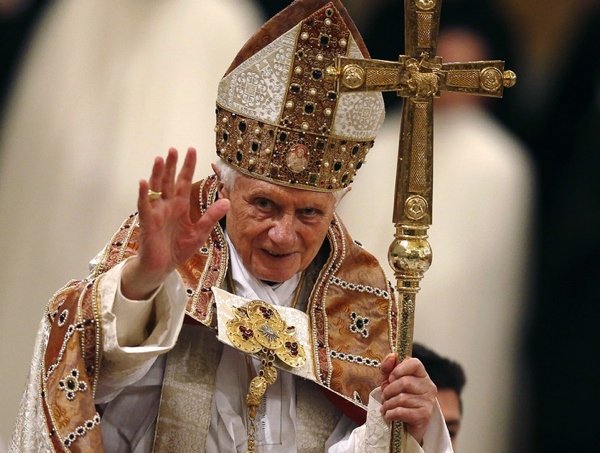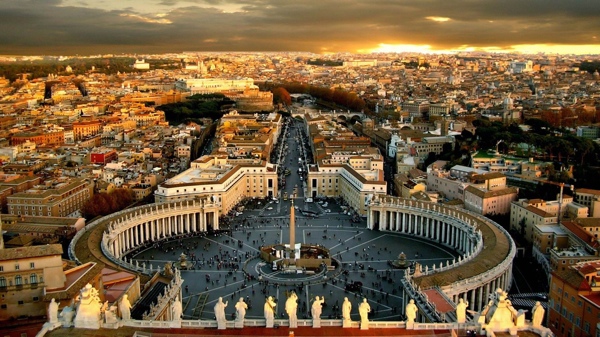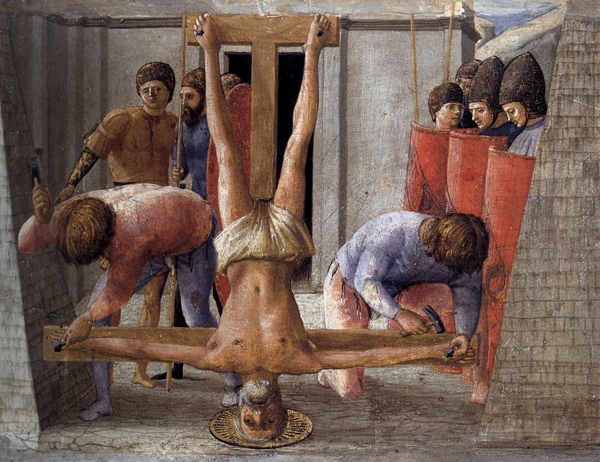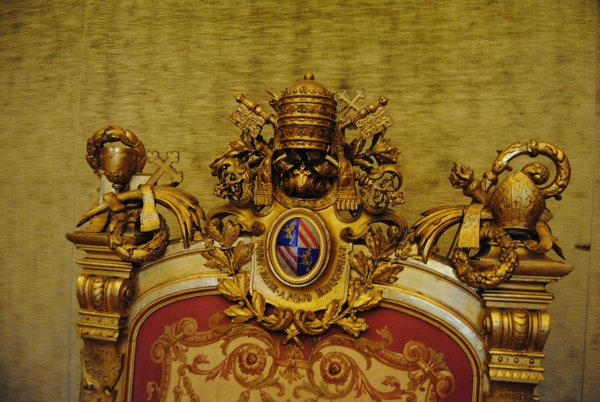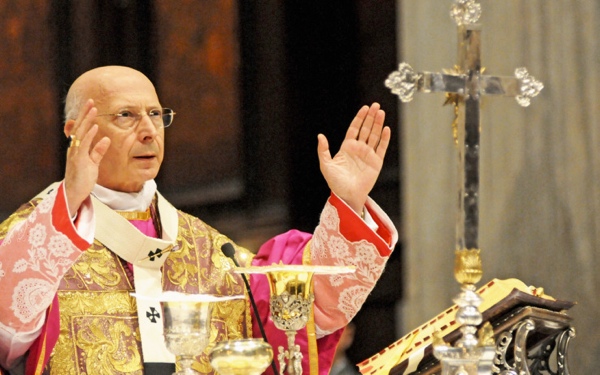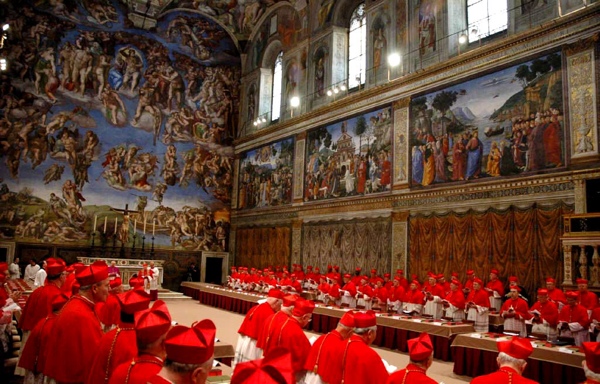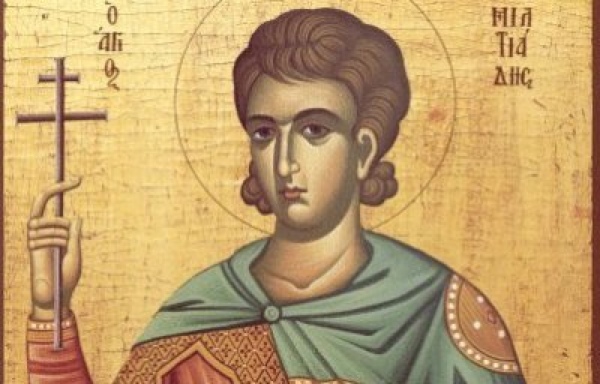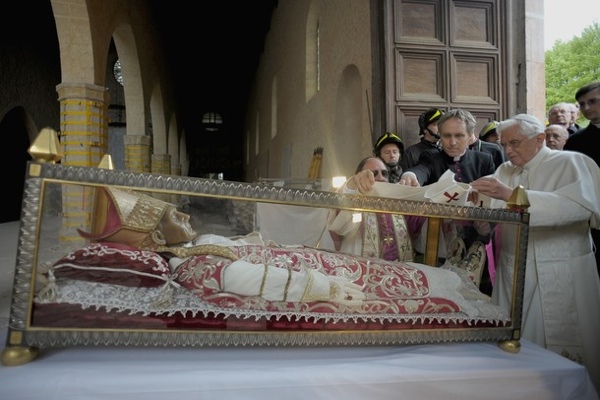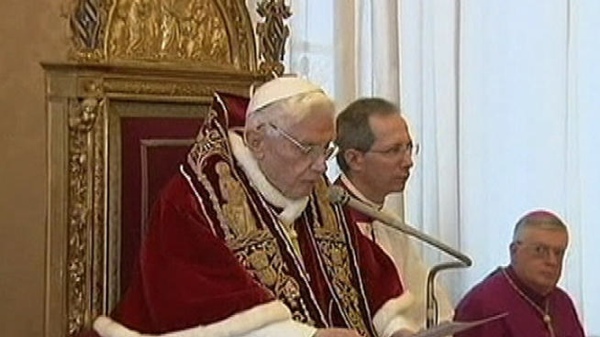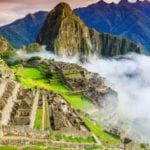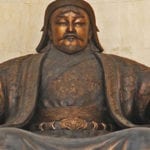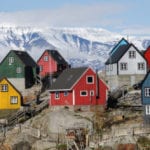The pope is supreme. He is an absolute monarch who answers to no man on earth. When Pope Benedict XVI abdicated he did not offer his resignation to anyone: he simply declared it to be so. The pope is the only absolute authority in the Church. He can overrule any decision made by his delegates in other countries—the bishops. Bishops do have a certain autonomy but their statements must always be in accord with the wishes of the pope. And, in turn, the pope’s decisions must always be in accord with every pope in the past. No pope can create a new dogma (teaching). He can only confirm the dogmas that have been held since the founding of the Church. So, for example, when the dogma of papal infallibility was declared by Blessed Pope Pius IX, it was not a new teaching or concept—it was a declaration that the issue has been held constantly and is no longer up for discussion. Pope John Paul II used infallibility to declare that women can never be ordained as priests in his letter Ordinatio Sacerdotalis in 1994, merely confirming what the church had always taught. While a few dissenters remain—who would strictly be defined as heretics—the majority of the Church has now accepted that women priests are impossible. The Church has a famous phrase which sums this up: “Roma locuta est, causa finita est”—“Rome [the pope] has spoken, the debate has ended.” This turns doctrine (long held beliefs whose finer points are still debated) into dogma (indisputable truths of the faith).
An antipope is a man who is considered by some to be the legitimate pope in opposition to the rightful one. History is riddled with these guys. During the Western Schism (a period in which the Church was rent apart with doctrinal discord) there were three popes who all had followers. In some cases even saints have been on the side of the wrong guy! But there can only ever be one lawful pope. When Pope Benedict XVI’s resignation takes effect, he is no longer pope. He will become Pope Emeritus. You may be surprised to know that there are a number of antipopes currently reigning (over rather tiny audiences in very bizarre circumstances). The second Vatican council in the 1960s introduced innovations to the Church that were unheard of. Some Catholics as a result went into a form of underground church but others decided that the popes of the council were false. Consequently their friends “elected” them “popes”. The most ridiculous—and sad—case is that of “Pope” Michael. Pope Michael currently reigns over a congregation of fifty faithful that includes his mom and a scattering of “catholics” on the Internet. Above is a ten minute documentary of Pope Michael who divides his time between writing papal encyclicals (letters), doing chores around the house, and working in civvies at the local timber mill.
Since the very first pope, Pope St. Peter, the Vatican has been an important place for the papacy. St. Peter was crucified upside-down and his bones were laid to rest at the Vatican hill. You can literally say that there has been a papal presence in the Vatican since the founding of the Church in the first century. But there was a time when the living pope did not reign from there. The Western Schism was a time of great discord in the Church. There were three men claiming to be the lawful pope and in the end it took the resignation of two and the deposition of a third to end the schism. The lawful pope—Pope Gregory XII—reigned from Avignon in France (you can still visit the papal palace there today), as did a number of his predecessors. His resignation ultimately allowed the schism to end, and a new pope—accepted by the whole Church—was elected: Pope Martin V. Interestingly, one of the antipopes involved took the regnal name of Pope John XXIII. Why is this interesting? Because the second Vatican council of 1962, which has caused so much distress in the modern Church was convoked by a second Pope John XXIII—Angelo Roncallli—who chose to reign under the name of an antipope: an act which was unheard of in the history of the Church and has not been repeated since.
In the Gospel of St. Matthew (16:18–19), Jesus says: “And I say to thee: That thou art Peter [Kephas: meaning rock]; and upon this rock I will build my church, and the gates of hell shall not prevail against it. And I will give to thee [Kephas: Peter] the keys of the kingdom of heaven. And whatsoever thou shalt bind upon earth, it shall be bound also in heaven: and whatsoever thou shalt loose upon earth, it shall be loosed also in heaven.” It was these words that gave St. Peter the authority to reign as the supreme head of Christ’s Church as Pope. The term pope—from Latin meaning father—did not come about as an official title until a few hundred years later, but the writings of the early Church fathers confirm that Peter was considered to be the first amongst all bishops. This has interestingly been a disputed point by many non-Catholic apologists (people who argue a point) refer to another Biblical phrase: “And call none your father upon earth; for one is your father, who is in heaven.” However this is merely semantics as Jesus is stating that you should not regard any man as equal to “the father”: i.e. God. The pope is “father” in the same sense as your dad is father. Jesus was speaking against idolatry not using the very specific word “father” to refer to a human. The pope is considered to be God’s representative on earth . . . not his equal. St. Peter chose his successors: Pope Linus (reigned 67–76), Pope Anacletus (79–92), and Pope Clement I (92–99). From Pope St. Peter to Pope Benedict XVI there is an undisputed line of 266 popes. Now . . . if you are clever you noticed that there were three years between Pope St. Linus and Pope St. Anacletus. That leads us to:
When a Pope dies—or abdicates as in our current situation—there is no pope. No committee of cardinals or bishops takes his place. There is simply no pope. This is called sede vacante—the see is vacant and we enter a period known as the interregnum: the time between popes. No new legislation can be proposed (as the pope is the supreme legislator) and no significant changes can occur within the Church. The papacy exists as an institution whether there is a man in it or not. Just as the British proclaim: “The King is dead. Long live the King,” the papal seat remains as an institution. Regardless of how long it takes to name a successor, the throne remains. Certain superiors in the Church have powers to maintain the legal aspects of the Church but they can not make doctrinal decisions and the power is very limited.
It is only human nature to speculate on the up-coming pope. At present a number of papabile—men likely to be elected pope—have been named. Below is a brief summary of the five appearing as the favorites. From least likely to win to most here they are: 5. Francis Arinze: Nigeria—80 years old. Cardinal Arinze is a great cardinal but his time has passed. It is very rare for a papabile to lose one election and win the next. The only way Arinze will be next pope is if the cardinals can’t make a choice after numerous attempts. In that case he will be picked as a pope who is not likely to live long enough to cause any damage. 4. Peter Turkson: Ghanaian—64 years old. Cardinal Turkson is probably too young to be the next pope. He has been appointed to many liberal congregations in the Church and has had a very positive influence politically in Africa but he is being touted as the next pope almost entirely because of his name (see item one on this list). If he were elected as a virtual unknown, the Church could potentially be looking at a twenty-year reign. For someone whose policies are unknown this is not appealing. 3. Marc Ouellet: Canadian—68 years old. Like Bagnasco below, Cardinal Ouellet has had a lot of input into the creation of bishops under Pope Benedict XVI. He is currently the head of the Canadian bishops conference. He is relatively conservative but his north American roots may work against him as the Church is global and many nations may be put off by his “American” accent. Yes—it can be as simple as that. 2. Angelo Scola: Italian—72 years old. Scola is a conservative Cardinal who is currently the Archbishop of Milan and previously the Patriarch of Venice. Both of these dioceses have given us popes in the recent past—both highly controversial. The Church isn’t looking for controversy right now. He has not had a remarkable Cardinalate which may work against him in the conclave.
- Angelo Bagnasco: Italian—70 years old. Cardinal Bagnasco is the Listverse pick for our next pope. He is generally conservative and is currently the Archbishop of Genoa and the head of three significant congregations in Rome. He has hand-picked many of the bishops created by Pope Benedict XVI so a lot of people owe him favors. He speaks five languages and is considered very approachable. He also looks like a pope (he is pictured above). He is currently the head of the Italian Bishops conference. His age is middling so if a two-thirds majority can’t be reached, he is still a likely candidate for an interim pope. If Angelo Cardinal Bagnasco is elected I foresee great changes happening in the Church.
Only cardinals (bishops in charge of churches within Rome) can vote. Only cardinals under eighty can vote. This conclave is different to the one which elected Pope Benedict XVI. Pope John Paul II changed the rules and allowed a fifty percent majority plus one to elect the pope. Pope Benedict XVI reversed this rule so this election will be under the traditional guidelines which requires a two thirds majority. The cardinals will meet in secrecy in the Sistine chapel until they elect a pope. There is no limit on how many times they will vote nor how many days it will take. Another change from the 1960s is that previous elections had the electors burn their votes with wet straw if they had not elected a pope. This caused black smoke to rise from the chimney. But in the 1960s chemicals were added to the mix to make the smoke more clearly black or white. As soon as white smoke emerges from the chimney on election day: Habemus Papam!—We have a Pope! To be elected pope you must be over the age of reason—generally accepted as seven years old—you must be male, and you must be baptized. The cardinals do not have to vote for one of their members: all male Catholics are eligible even if they are not priests.
The American media is spouting the usual “Obama moment” clichés about the up and coming election and are excited by the fact that the Church might follow America’s forward-thinking and elect a black pope. The only problem is . . . the Church has already had a black pope. Pope St. Miltiades reigned from 311–314. He was the reigning Pope when the emperor Constantine gave the Lateran palace to the Church. This palace remains to this day the home of the reigning pope. In addition to a black pope, the Church has also had seven popes from the Middle East. Sorry American media: the Church had its Obama moment 1,700 years before you.
The pope has abdicated. What happens now? Because there can only be one pope, Pope Benedict XVI will no longer be referred to as your holiness or pope. He will become the Bishop Emeritus (retired bishop) of Rome. When greeting him face-to-face the correct terms are “Your Excellency” or “My Lord.” He will be Bishop Ratzinger, not Cardinal Ratzinger as his cardinalate of Ostia (church in Rome over which he presided before becoming pope) is now in someone else’s hands. So—to clarify—Bishop Ratzinger will have no special authority over the Church. His plans are to go into reclusion in a cloister within the Vatican. It is very likely that his face will not be seen again in public after 8pm on the 28th of February, 2013. He intends to spend the remainder of his life praying for the good of the Church and writing. There is far too great a risk of confusion occurring if he were to speak publicly during the reign of the next pope. Pope Benedict XVI will maintain his current appointments until his abdication date. His abdication has ended the process for the canonization (saint-making) of Pope John Paul II and the beatification (making a blessed) of Pope Paul VI—two of his predecessors who are both controversial: John Paul II for presiding over the child abuse scandal and Paul VI for the damage caused to the Church by his decisions after the second Vatican council. And for the record, his abdication is not as shocking as it may seem in retrospect: he gave a number of hints about it by referring to papal abdications from the past and, perhaps most obviously, visited the tomb of the last pope to voluntarily resign—Pope St. Celestine V—and symbolically removed his pallium (a sign of his office) and laid it to rest on the grave (picture above).
In the Middle Ages a document came to light. It was a list of popes from the past and into the future. It was as cryptic as anything penned by Nostradamus but it earned itself a great reputation for its accuracy. Rather than naming the popes by name or regnal title, it gave a short description. Because it was very accurate regarding popes prior to its discover some say it is a medieval forgery, but certain recent popes have fit the bill rather well. The prophecy is attributed to 12th century Archbishop St Malachy. Here are the predictions for the last two popes: From the Labour of the Sun: Pope John Paul II was born and buried during a solar eclipse Glory of the Olive: Pope Benedict XVI chose the regnal name Benedict. The benedictines have an olive branch on their coat of arms The next prediction on the list is the last pope named. In other words, if the prophecy is true the next pope will be the last pope. This is meant to indicate the beginning of the great tribulation: the end of times. He is to be: Petrus Romanus—Peter the Roman. Of the most likely candidates for the papacy at the moment we have three Italians (Romans) and one African Cardinal whose first name is Peter.
The two main thoughts on this point at present are:
- To prevent the canonization of John Paul II and beatification of Paul VI, both of whom presided over two of the biggest scandals in recent Church history. 2. In order to indirectly manage the election of a pope he approves of. John Paul II was the pope while the majority of the sexual-abuse scandal occurred in the Church. Yet he did nothing about it and allowed bishops to continue to hide the details from the civil law. Yet many Catholics saw him in such high regard that he earned such obscene epithets as “John Paul the Great.” After his death there was such a strong drive to canonize him that things got out of hand. It is possible that Pope Benedict XVI has resigned in order to put a halt to the saint-making mechanism that will declare him a saint in 2014. Interestingly, Pope Benedict XVI had already postponed the canonization by a year shortly prior to his abdication. Whereas Pope Benedict XVI symbolically placed his pallium on the tomb of his predecessor, Pope Paul VI—who is supposed to be beatified next year—symbolically gifted his papal tiara (crown) to the United Nations. By many this was seen as the Church stepping down and giving its religious authority to a political organization. Given the Church’s history of opposing governments in cases such as slavery, this was a complete reversal of Church policy. It was an apparent attempt to join Church and state in a macabre manner. The Church has always considered the proper separation of Church and state to mean that the state stays away from religion, this was a pope asking the state to intervene in religion. In our second scenario, Pope Benedict XVI was—prior to his elevation as Supreme Pontiff—the head of the Holy Office of Inquisition: now known as the Congregation for the Doctrine of the Faith. That put him in a position to know every dirty little secret in the Vatican. He merely needs to remind a few cardinals about scandalous secrets that could leak out if they don’t comply with his wishes with regards to the next pope. Only time will tell. Read More: Facebook Instagram Email
